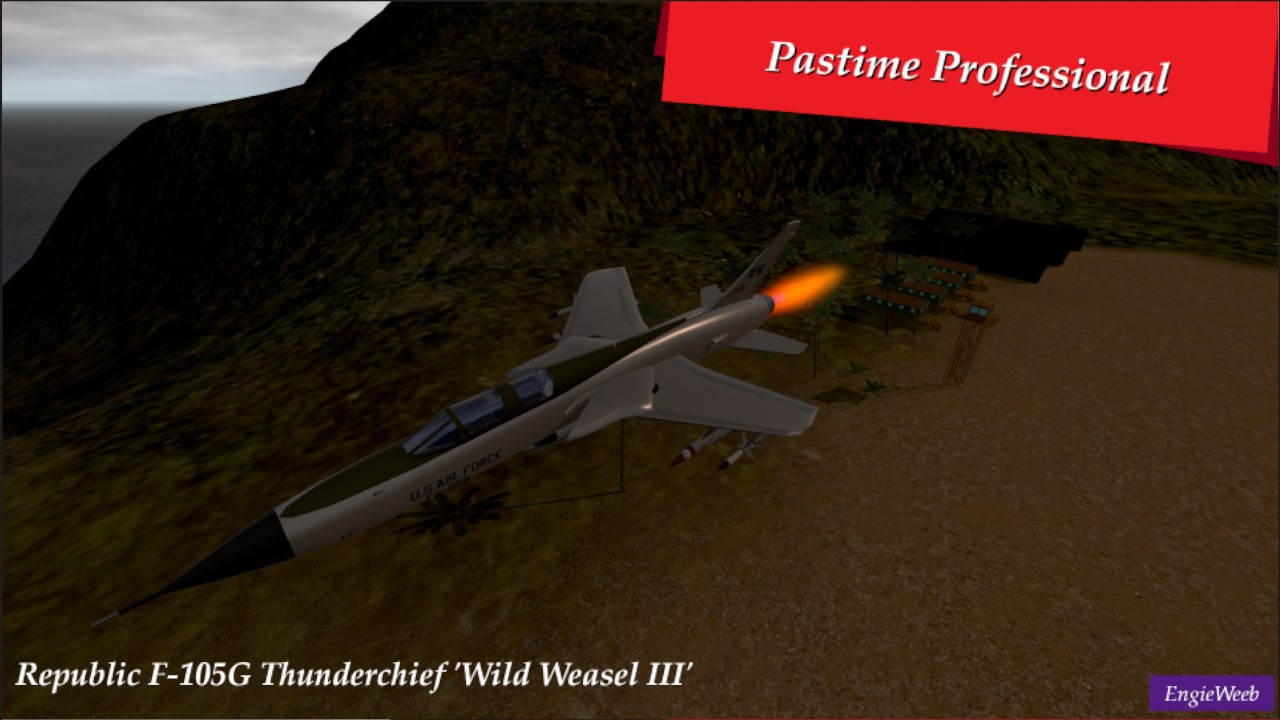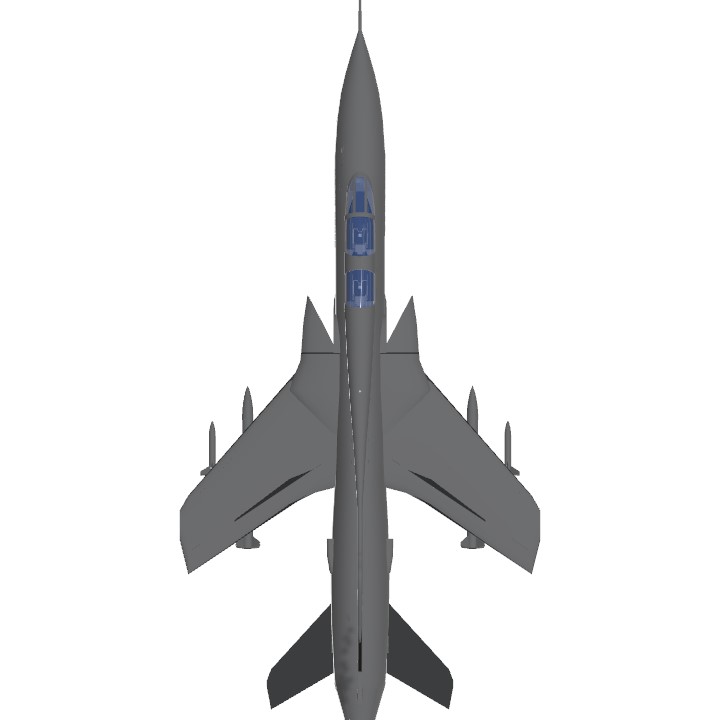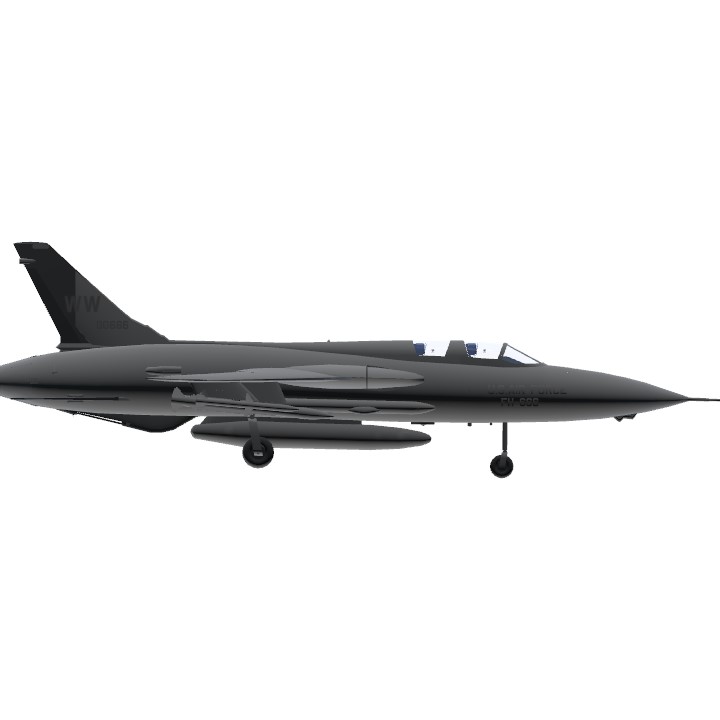Had this sitting around for a while, figured I would actually post it. As much as I like the F-105 IRL, this was probably one of the most frustrating builds to work on; I was switching between 3-5 different blueprints of both single-and-twin seaters, they all had variances in the lines and scale, and you would be surprised how few blueprints exist for the -105F and G...especially ones that have the godforsaken landing gear down.
Was gonna do an asymmetrical loadout with a 450US Gal wing tank, one AGM-78, the centerline 650 tank, and the two shrikes, but not only does it (obviously) mess with flight performance, takeoff was pretty much impossible. Even when I adjusted liftScale on the rudder, it wouldn't lift off until about 200kts which...no. So, this build didn't exactly endear me to it after a while. It's rough, and I'm not overly proud of it as a whole, but it'll suffice.
Also I put this in the early baremetal livery because camo is pain. Also just makes my build a touch more interesting to look at, me thinks.
Controls
Group1 - Emergency tailhook
Group2 - Drogue chute
Group3 - N/A
Group4 - Jettison drop tank
Group5 - Airbrake
Group6 - Jettison weapon stores
Group7 - N/A
Group8 - Master arm
VTOL - Flaps
Trim - Pitch trim
Loadout
1X M61A1 Vulcan, 1028 rounds
2x China Lake AGM-45A Shrike
2x General Dynamics AGM-78A Standard ARM
1x 650US Gal centerline drop tank
Short History

This is actually an F-105F Wild Weasel II; note no ECM pod bulges on fuselage
Modified from twin-seat F-105F Thunderchief's already in service with the USAF, The F-105G Thunderchief was a specially modified variant built with the express purpose of performing the evolving 'Wild Weasel' SEAD (Suppression of Enemy Air Defenses) mission task. With lessons learned from the -105F Wild Weasel II's fresh in the Air Force's mind, the new iteration received a new suite of avionics for use in detecting and combating the radar systems used by Vietnamese AA(A) and SAM sites to fire on US strike packages. This included a new radar warning receiver (for general detection of enemy radar), radar homing and warning system (for more precise targeting compared to the RWR), a new launch warning receiver, and the addition of an electronic countermeasures pod split in two and melded to the lower fuselage. This gave the new Wild Weasel III a distinct look compared to the earlier version, and it also had the benefit of freeing up all five pylons for use to carry stores. Crews carried a variety of arms for their special mission, but the consistent favorites by the close of Operation Rolling thunder appears to have been some combination of AGM-45A Shrike and AGM-78A/B Standard ARM missiles; cluster bombs also seem to have stayed in use for leveling the sites themselves.
Unlike the regular F-105D single-seaters, the -105F and G variants stayed in use right to the end of US involvement in Vietnam and the greater SEA region, performing their dangerous game of hide and seek alongside F-4 Phantoms set aside to provide the killing power against Vietnamese ground defenses. Their legacy of the Wild Weasel mission stays in effect today thanks to dedicated F-16C's (sometimes called F-16CJ), and it's likely the F-35 will take over the SEAD job as they trickle into service with US and other nations.
Specifications
General Characteristics
- Created On Windows
- Wingspan 35.1ft (10.7m)
- Length 70.2ft (21.4m)
- Height 23.0ft (7.0m)
- Empty Weight 35,718lbs (16,201kg)
- Loaded Weight 50,493lbs (22,903kg)
Performance
- Power/Weight Ratio 0.485
- Wing Loading 98.6lbs/ft2 (481.5kg/m2)
- Wing Area 512.0ft2 (47.6m2)
- Drag Points 1120
Parts
- Number of Parts 342
- Control Surfaces 10
- Performance Cost 1,571





@ChiChiWerx Y'know, thinking about it, given the small-ish wing relative to the size of the plane I suppose that makes sense in retrospect. I'll keep this in mind if I ever remake my F-105D build.
.
I think I was more concerned about how it aggressively drifted with the original planned configuration (I've never known how much these drop tanks weigh by themselves, no fuel). The asymmetric AGM-78/drop tank setup just wasn't going to work, sadly.
.
If there's anything else I didn't get quite right I'd love to know. Good to see a comment from you again too. :)
200 KIAS liftoff wasn’t actually unrealistic. Fully loaded out in hot weather, the bomber version of the “Thud” would often lift off at 230 KIAS. The WW, though, was a bit lighter without all those iron bombs, so takeoffs were a bit slower. All those Century series jets had high takeoff, approach and landing speeds.
When the weasel goes wild O_O
@TheCommentaryGuy wut
pookie bear finally made the thud